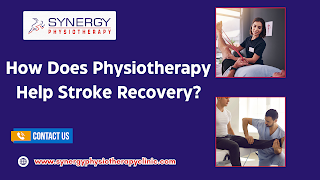How Does Physiotherapy Help Stroke Recovery?
Introduction
Stroke is a serious medical condition that occurs when the blood supply to the brain is disrupted, leading to damage to brain cells. This can result in paralysis, loss of motor function, speech impairment, and cognitive difficulties. Recovery from a stroke requires a multidisciplinary approach, with physiotherapy playing a crucial role in helping patients regain mobility and independence. Physiotherapy aids stroke patients by improving movement, strength, coordination, and overall quality of life.
Restoring Mobility and Motor Function
A primary goal of physiotherapy in stroke recovery is to restore lost mobility. Strokes often lead to muscle weakness, paralysis (typically on one side of the body), and difficulty coordinating movements. Physiotherapists work closely with patients to retrain their brain and body through various exercises and techniques that improve movement and regain control over affected limbs. Repetitive task training, such as lifting objects, walking, or grasping, helps stimulate neuroplasticity—the brain’s ability to rewire itself and create new neural pathways. This allows stroke survivors to gradually regain lost functions over time.
Improving Muscle Strength and Endurance
The most common consequence of a stroke is muscle weakness. Physiotherapy includes strength training exercises to enhance muscle endurance and prevent muscle atrophy. These strengthening exercises focus on key muscle groups, improving the patient’s ability to stand, walk, and perform daily activities. Resistance training, weight-bearing exercises, and functional movement training are incorporated into physiotherapy programs to help muscles regain strength and endurance. A gradual increase in exercise intensity enables stroke patients to become more active and independent.
Improving Balance and Coordination
Stroke can significantly affect a person's balance and coordination, increasing the risk of falls and injuries. Physiotherapists implement balance training exercises that help patients stabilize their posture and enhance coordination. Activities such as standing on one leg, walking on different surfaces, and using stability balls are used to improve balance. These exercises are crucial for stroke patients to regain confidence in their movements and prevent falls, which could further complicate their recovery.
Reducing Spasticity and Muscle Stiffness
Spasticity, or muscle stiffness, is a common issue for stroke patients. It can make movement difficult and even painful. Physiotherapists employ stretching exercises, range-of-motion activities, and manual therapy techniques to reduce spasticity and improve flexibility. Techniques such as passive stretching, active-assisted movements, and joint mobilization help keep affected muscles relaxed and functional. This not only aids in movement recovery but also alleviates discomfort and pain.
Improving Gait and Walking Ability
Walking independently after a stroke can be a significant challenge. Physiotherapy plays an essential role in improving gait (walking pattern) through targeted exercises and assistive devices. Therapists work on correcting walking patterns, increasing stride length, and ensuring proper foot placement. Treadmill training, gait retraining exercises, and the use of orthotics or walking aids assist stroke survivors in regaining confidence and improving mobility. The goal is to restore normal walking patterns and gradually reduce dependence on assistive devices over time.
Promoting Neuroplasticity and Brain Recovery
The brain has an incredible ability to adapt and rewire itself after an injury, a process known as neuroplasticity. Physiotherapy encourages neuroplasticity by promoting repetitive movements and exercises that stimulate brain activity. Techniques such as task-specific training, mirror therapy, constraint-induced movement therapy (CIMT), and virtual reality-based exercises are used in physiotherapy to enhance brain recovery. These methods help the brain form new connections and improve movement control in affected areas.
Addressing Speech and Swallowing Difficulties
A stroke can impact the muscles involved in speech and swallowing, resulting in communication challenges and dysphagia (difficulty swallowing). Physiotherapists collaborate with speech therapists to improve oral motor control and strengthen the muscles responsible for speech and swallowing. Facial exercises, tongue exercises, and breathing control techniques are effective in enhancing speech clarity and swallowing function, enabling stroke patients to communicate more effectively and consume food safely.
Psychological and Emotional Benefits
Recovery from a stroke involves not only physical rehabilitation but also emotional and psychological healing. Stroke survivors frequently experience depression, anxiety, and frustration due to the difficulties in regaining lost functions. Physiotherapy provides emotional support by motivating patients to set realistic goals and celebrate small victories. Improvement in physical abilities boosts self-esteem and confidence, contributing to a better overall quality of life.
Conclusion
Physiotherapy is a vital part of stroke recovery, helping patients regain mobility, strength, and independence. By promoting neuroplasticity, improving motor function, and reducing muscle stiffness, physiotherapy enhances the overall rehabilitation process. With personalized treatment plans and continuous support, stroke survivors can improve their quality of life and work towards a successful recovery.
More Information:
Landline No: 080-43742949
Mobile Number: +91 9738751252 / +91 8050505888
E-Mail: synergyphysioclinic@gmail.com
Website: https://www.synergyphysiotherapyclinic.com


.png)

Comments
Post a Comment